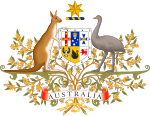 | |
| Date | October – November 1975 |
|---|---|
| Location | Canberra, Australian Capital Territory: |
| Participants | |
| Outcome |
|
The 1975 Australian constitutional crisis, also known simply as the Dismissal, culminated on 11 November 1975 with the dismissal from office of the prime minister, Gough Whitlam of the Australian Labor Party (ALP), by Sir John Kerr, the Governor-General who then commissioned the leader of the Opposition, Malcolm Fraser of the Liberal Party, as prime minister to hold a new election. It has been described as the greatest political and constitutional crisis in Australian history.
The Labor Party under Gough Whitlam came to power in the election of 1972, ending 23 consecutive years of Liberal-Country Coalition government. Labor won a majority in the House of Representatives of 67 seats to the Coalition's 58 seats, but faced a hostile Senate. In May 1974, after the Senate voted to reject six of Labor's non-supply bills, Whitlam advised governor-general Sir Paul Hasluck to call a double dissolution election. The election saw Labor re-elected, with its House of Representatives majority reduced from 9 to 5 seats, although it gained seats in the Senate. With the two houses of Parliament still deadlocked, pursuant to section 57 of the Australian Constitution, Whitlam was able to narrowly secure passage of the six trigger bills of the earlier double dissolution election in a joint sitting of Parliament on 6–7 August 1974, the only such sitting held in Australia's history.
Whitlam's tenure in office proved highly turbulent and controversial, and in October 1975, the Opposition under Malcolm Fraser used its control of the Senate to defer passage of appropriation bills needed to finance government expenditure which had already been passed by the House of Representatives. Fraser and the Opposition stated that they would continue to block supply in the Senate unless Whitlam called a fresh election for the House of Representatives, and urged Governor-General Sir John Kerr, who had been appointed governor-general on Whitlam's advice in July 1974, to dismiss Whitlam unless he acceded to their demand. Whitlam believed that Kerr would not dismiss him as prime minister, and Kerr did nothing to make Whitlam believe that he might be dismissed.
On 11 November 1975, the crisis came to a head as Whitlam went to seek Kerr's approval to call a half-Senate election in an attempt to break the parliamentary deadlock. Kerr did not accept Whitlam's request, and instead dismissed him as prime minister and appointed the leader of the Opposition, Malcolm Fraser, as prime minister on the understanding that Fraser would act as a caretaker and immediately call a general election. Acting quickly before all ALP parliamentarians became aware of the change of government, Fraser and his parliamentary allies were able to secure passage of the supply bills through the Senate and advised Kerr to dissolve Parliament for a double dissolution election. Fraser and his Liberal-Country Coalition were elected with a massive majority in the federal election held the following month.
The events of the Dismissal led to only minor constitutional change. The Senate retained its power to block supply, and the governor-general the power to dismiss government ministers; however, these powers have not since been used to force a government from office. Despite being denied by both Kerr and Whitlam, allegations have repeatedly been made about CIA involvement in the Whitlam dismissal, but remain unsubstantiated. Kerr was widely criticised by Labor supporters for his actions, resigned early as governor-general, and lived much of his remaining life abroad.
| ||
|---|---|---|
Term of government (1972–1975)
Ministries Elections Related |
||
